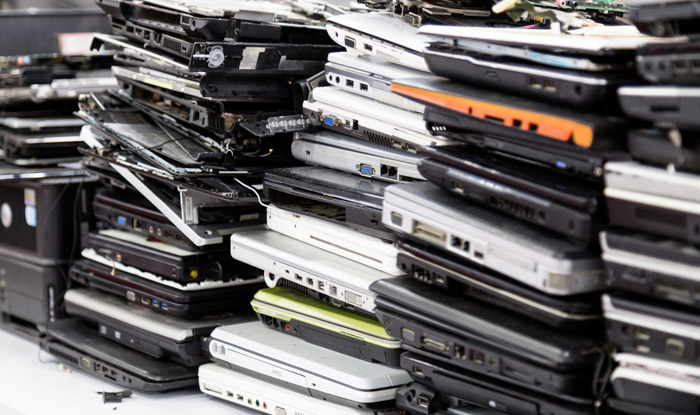
Photo Credit: iStock/ThamKC
E-waste is a colossal problem and grows more complex each day. Every day we dump boatloads of electronic waste into our landfills, polluting our environment, soil, and water sources.
Though there are treatment options in place, e-waste recycling, for example, the problem is just too vast and has too many moving pieces to address it properly. It will take a global reckoning to put this issue right.
In the meantime, companies like Hummingbird International are committed to doing their bit and making e-waste recycling more convenient and accessible to the public.
To that end, we are writing this post to shed light on some of the most common categories of electronic waste. Understanding these classifications will help users and consumers to categorize their e-waste more consciously, improve customer experience, and thus, make their recycling efforts more effective.
The ICT sector is one of the fastest-growing segments of the global economy. It is also the largest contributor to the global e-waste crisis.
ICT equipment refers to common personal use electrical and electronic items, such as:
Proper recycling of these items can help us recover billions of dollars worth of raw materials; precious metals such as gold, palladium, copper, and iron, among others.
As you can infer by the name, this category covers large appliances that we use at homes. These include:
Each year, more than 98.2% of household e-waste generated by large appliances ends up in landfills. As with every other category on this list, this careless dumping not only costs in terms of environmental impact but also loss of precious metals.
Most towns in America offer convenient recycling options that take care of small household appliances. In many cases, these facilities offer free-of-cost services.
The small household appliances, also called consumer electronics, that you can send for recycling include things like:
One of the top reasons that these small appliances make up the bulk of the e-waste issue is that they aren’t reparable. By abolishing the culture of obsolescence and holding companies accountable to create easily repairable products, we can progress towards real change.
Tools that you need to process materials such as wood, metal, and others cover this category. They can be large or small and like other forms of e-waste are injurious to the environment.
Some common culprits found under this tag include:
Improper handling of discarded E&E tools releases toxins, poisons, and acids into the earth that eventually make their way into human and animal blood streams, causing illnesses and deaths.
Lighting equipment is such a prevalent part of modern life that we don’t even notice them anymore. Every time you enter a room and hit the light switch, you do it without thinking. Switching on the lamp when you wake up in the middle of the night is also standard subconscious stuff.
So, what are some of the most common lighting equipment with the most potential of turning into e-waste?
This category produces some of the fastest-growing e-waste surplus. Reasons being that children quickly outgrow their toys or they become faulty after much use. Regular updates in gaming software and hardware also adds to the problem by forcing consumers to buy the latest gadgets to enjoy the most recent updates and features.
Some well-known items that make this list are things such as:
By donating our old toys or sporting and leisure equipment, we can save a lot of perfectly good devices from being dumped into the garbage and even begin to close the digital divide that’s plaguing our communities.
There is a wide range of equipment — big and small — that cover this section. Electric or electronic medical devices or those that contain such components become a substantial part of our annual e-waste data.
Here’s how healthcare’s e-waste looks like:
One of the critical issues rampant in relation to healthcare e-waste is that any irresponsible or careless resale, donation, or recycling attempt can result in severe data breaches — something the industry already acutely suffers from. Businesses like Hummingbird International become mission critical for responsible disposal of medical e-waste.
Electronic or electrical devices that we use to control the environment around us fall into this category. This includes devices that help us monitor temperature, activity, and climate. It also refers to dispensing devices such as coffee or water dispensers or ATMs.
Here is a short list of the most common M&C equipment found in e-waste dumps.
As we go farther into the digital age, we leave behind a trail of massive destruction — of resources, planet, environment, and human health. Electric and electronic devices that have irreparable parts, shorter life cycles, and poor recycling capabilities affect the overall wellbeing of our dear planet and dear lives. To understand this problem and its enormity, we hope this brief guide proves helpful.
We have shared here 8 of the most common classifications of e-waste streams and tried to give you a scope of the matter we are dealing with.
Use this information to classify and categorize electric/electronic devices in your home and office so you can pass the first step towards responsible recycling.
For more information and details, give our representative a call at +1 (888) 392-7839.
Kelly Sampson is a writer, blogger, and environmental enthusiast. She has strong opinions about climate change, the dogs vs. cats debate, and Oxford commas. She has lent Hummingbird International her engaging and spirited voice and turned our blog into a great place to find valuable information about e-waste, e-waste recycling, and the ITAD industry. Explore our blog to read more of her work.